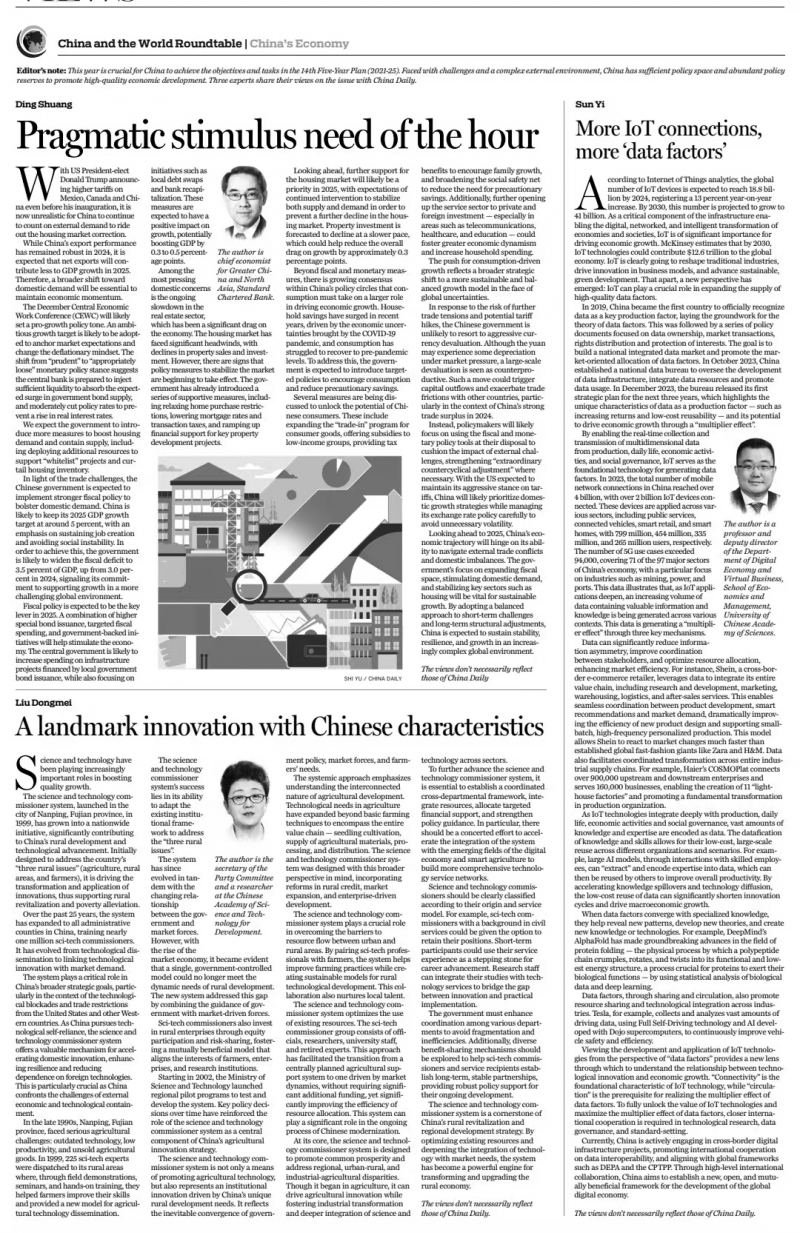【中国日报(海外版)】刘冬梅:A landmark innovation with Chinese characteristics

Science and technology have been playing increasingly important roles in boosting quality growth.
The science and technology commissioner system, launched in the city of Nanping, Fujian province, in 1999, has grown into a nationwide initiative, significantly contributing to China's rural development and technological advancement. Initially designed to address the country's "three rural issues" (agriculture, rural areas, and farmers), it is driving the transformation and application of innovations, thus supporting rural revitalization and poverty alleviation.
Over the past 25 years, the system has expanded to all administrative counties in China, training nearly one million sci-tech commissioners. It has evolved from technological dissemination to linking technological innovation with market demand.
The system plays a critical role in China's broader strategic goals, particularly in the context of the technological blockades and trade restrictions from the United States and other Western countries. As China pursues technological self-reliance, the science and technology commissioner system offers a valuable mechanism for accelerating domestic innovation, enhancing resilience and reducing dependence on foreign technologies. This is particularly crucial as China confronts the challenges of external economic and technological containment.
In the late 1990s, Nanping, Fujian province, faced serious agricultural challenges: outdated technology, low productivity, and unsold agricultural goods. In 1999, 225 sci-tech experts were dispatched to its rural areas where, through field demonstrations, seminars, and hands-on training, they helped farmers improve their skills and provided a new model for agricultural technology dissemination.
The science and technology commissioner system's success lies in its ability to adapt the existing institutional framework to address the "three rural issues".
The system has since evolved in tandem with the changing relationship between the government and market forces. However, with the rise of the market economy, it became evident that a single, government-controlled model could no longer meet the dynamic needs of rural development. The new system addressed this gap by combining the guidance of government with market-driven forces.
Sci-tech commissioners also invest in rural enterprises through equity participation and risk-sharing, fostering a mutually beneficial model that aligns the interests of farmers, enterprises, and research institutions.
Starting in 2002, the Ministry of Science and Technology launched regional pilot programs to test and develop the system. Key policy decisions over time have reinforced the role of the science and technology commissioner system as a central component of China's agricultural innovation strategy.
The science and technology commissioner system is not only a means of promoting agricultural technology, but also represents an institutional innovation driven by China's unique rural development needs. It reflects the inevitable convergence of government policy, market forces, and farmers' needs.
The systemic approach emphasizes understanding the interconnected nature of agricultural development. Technological needs in agriculture have expanded beyond basic farming techniques to encompass the entire value chain — seedling cultivation, supply of agricultural materials, processing, and distribution. The science and technology commissioner system was designed with this broader perspective in mind, incorporating reforms in rural credit, market expansion, and enterprise-driven development.
The science and technology commissioner system plays a crucial role in overcoming the barriers to resource flow between urban and rural areas. By pairing sci-tech professionals with farmers, the system helps improve farming practices while creating sustainable models for rural technological development. This collaboration also nurtures local talent.
The science and technology commissioner system optimizes the use of existing resources. The sci-tech commissioner group consists of officials, researchers, university staff, and retired experts. This approach has facilitated the transition from a centrally planned agricultural support system to one driven by market dynamics, without requiring significant additional funding, yet significantly improving the efficiency of resource allocation. This system can play a significant role in the ongoing process of Chinese modernization.
At its core, the science and technology commissioner system is designed to promote common prosperity and address regional, urban-rural, and industrial-agricultural disparities. Though it began in agriculture, it can drive agricultural innovation while fostering industrial transformation and deeper integration of science and technology across sectors.
To further advance the science and technology commissioner system, it is essential to establish a coordinated cross-departmental framework, integrate resources, allocate targeted financial support, and strengthen policy guidance. In particular, there should be a concerted effort to accelerate the integration of the system with the emerging fields of the digital economy and smart agriculture to build more comprehensive technology service networks.
Science and technology commissioners should be clearly classified according to their origin and service model. For example, sci-tech commissioners with a background in civil services could be given the option to retain their positions. Short-term participants could use their service experience as a stepping stone for career advancement. Research staff can integrate their studies with technology services to bridge the gap between innovation and practical implementation.
The government must enhance coordination among various departments to avoid fragmentation and inefficiencies. Additionally, diverse benefit-sharing mechanisms should be explored to help sci-tech commissioners and service recipients establish long-term, stable partnerships, providing robust policy support for their ongoing development.
The science and technology commissioner system is a cornerstone of China's rural revitalization and regional development strategy. By optimizing existing resources and deepening the integration of technology with market needs, the system has become a powerful engine for transforming and upgrading the rural economy.
(The author is the secretary of the Party Committee and a researcher at the Chinese Academy of Science and Technology for Development.)
(https://enapp.chinadaily.com.cn/a/202412/12/AP675a0ee2a3103f0966a0c4ab.html)
 联系我们
联系我们
地址:中国 北京市海淀区玉渊潭南路8号 邮编(ZIP):100038
电话(Tel):86-10-58884543 咨询:webmaster@casted.org.cn 新闻与信息:xxxz@casted.org.cn
![]() 版权所有 必赢线路检测3003no1 - 必赢线路检测3003 备案号/经营许可证备号:京ICP备10036465号-11
技术支持:中研网
版权所有 必赢线路检测3003no1 - 必赢线路检测3003 备案号/经营许可证备号:京ICP备10036465号-11
技术支持:中研网




